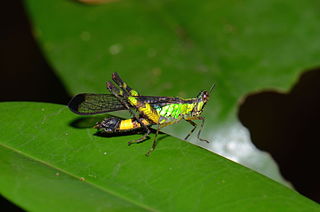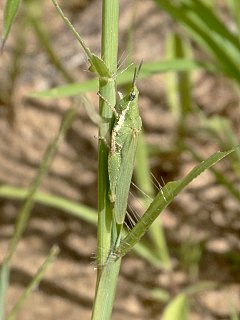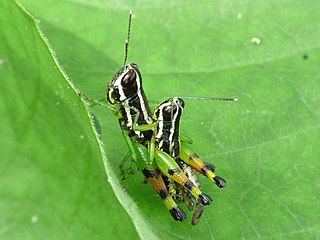
The Acrididae are the predominant family of grasshoppers, comprising some 10,000 of the 11,000 species of the entire suborder Caelifera. The Acrididae are best known because all locusts are of the Acrididae. The subfamily Oedipodinae is sometimes classified as a distinct family Oedipodidae in the superfamily Acridoidea. Acrididae grasshoppers are characterized by relatively short and stout antennae, and tympana on the side of the first abdominal segment.

Bandwings, or band-winged grasshoppers are the subfamily Oedipodinae of grasshoppers classified under the family Acrididae. They have a worldwide distribution and were originally elevated to full family status as the Oedipodidae. Many species primarily inhabit xeric weedy fields, and some are considered to be important locusts:

The grasshopper subfamily Acridinae, sometimes called silent slant-faced grasshoppers, belong of the large family Acrididae in the Orthoptera: Caelifera.
Tauchira is a genus of grasshoppers in the subfamily Catantopinae and tribe Tauchirini. Species can be found in South-East Asia.

Tetrigidae is an ancient family in the order Orthoptera, which also includes similar families such as crickets, grasshoppers, and their allies. Species within the Tetrigidae are variously called groundhoppers, pygmy grasshoppers, pygmy devils or "grouse locusts".

Chorotypidae is a family of tropical Asian grasshoppers. These grasshoppers have a head that rises above the level of the thorax and short antennae. Some species have reduced wings, others have wings that widen towards the tips and still others have a flattened leaf-like shape. They lack abdominal tympani.

Oxyinae is subfamily of grasshoppers in the family Acrididae. Species are distributed throughout Africa and Australasia.

The Cyrtacanthacridinae are a subfamily of Orthoptera: Caelifera in the family Acrididae. They are sometimes referred-to as bird locusts, criquets voyageurs in French-speaking Africa, and Knarrschrecken in German.

Valanga is a genus of "bird grasshoppers" in the subfamily Cyrtacanthacridinae. Species are found from the Indian subcontinent through southeast Asia and the Korean peninsula to Australia and the Pacific islands.
Dericorythidae are a family of grasshoppers, in the Orthoptera: suborder Caelifera. Species in this family can be found in northern Africa, southern Europe and Asia.

Erianthus is a genus of grasshoppers restricted to Southeast Asia. They occur in Japan, northeast India, Myanmar, Thailand, Vietnam, South China including Hong Kong, and extend east to Sumatra. In the past some neotropical species were also included in the genus. They have narrow ranges and species are identifiable only by their characteristics of male and female genitalia.

The Hexacentrinae, are a subfamily of predatory bush crickets or katydids. The type genus is Hexacentrus, which are also known as balloon-winged katydids. The group has sometimes been treated as a tribe within Conocephalinae, which may be a sister group. Members of this subfamily have lobules on the male paraprocts. Most of them also have a flat, wide hind lobe of the pronotum.

Xenocatantops is a genus of grasshoppers in the subfamily Catantopinae and tribe Catantopini. Species can be found in Africa, India, China, Indo-China and Malesia.

The Pyrgomorphinae are a sub-family of grasshoppers in the family Pyrgomorphidae. Species are found in, especially the warmer parts of: Central and South America, southern Europe, Africa, Asia, Australia and Pacific Islands. The type genus is Pyrgomorpha and names dates from "Pyrgomorphiden" by Brunner von Wattenwyl, 1874. The first use of Pyrgomorphinae was by Krauss in 1890.

The Orthacridinae are a sub-family of grasshoppers in the family Pyrgomorphidae. Species are found in: Central America, Africa, Asia, Australia and certain Pacific Islands. The type genus is Orthacris and the taxon proposed by Bolívar in 1905.

Tetriginae is a large subfamily of groundhoppers or pygmy grasshoppers. Members of Tetriginae occur on every continent except Antarctica.

Erucius is a genus of grasshoppers in the family Chorotypidae. Species in this genus can be found in Vietnam and Malesia, including the Philippines. It is the only genus in the subfamily Eruciinae.

Traulia is a genus of grasshoppers in the subfamily Catantopinae; it was considered typical of tribe Trauliini, but is now placed in the tribe Mesambriini. A majority of species found in South-East Asia.

Cladonotinae is a subfamily of pygmy grasshoppers in the family Tetrigidae. There are more than 70 genera and 260 described species in Cladonotinae.
Trigonopteryx is an Asian genus of grasshoppers: typical of the family Trigonopterygidae




















